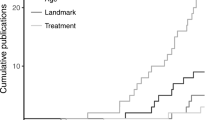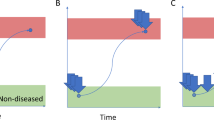Abstract
Purpose of Review
Immortal time occurs when study subjects’ person-time is misclassified. For example, if exposure is assigned over time, but treated as a binary “ever-exposed” variable, subjects in the exposed group are “immortal” prior to their exposure. We describe immortal time and the context in which it introduces bias and describe several approaches to avoid immortal time bias via design or mitigate it through analysis.
Recent Findings
Several authors have described examples of immortal time bias in clinical epidemiology, pharmacoepidemiology, and perinatal epidemiology. Solutions to immortal time bias include analyses that appropriately account for time-varying exposure, and design solutions that align exposure with the start of follow-up.
Summary
Immortal time bias is pervasive in epidemiology. It can cause substantial bias. It is, however, easily avoided and can be controlled using appropriate analytic and design strategies.

Similar content being viewed by others
References
Papers of particular interest, published recently, have been highlighted as: • Of importance
Hanley JA, Foster BJ. Avoiding blunders involving ‘immortal time’. Int J Epidemiol. 2014;43(3):949–61.
Farr W. Vital statistics. London: The Sanitary Institute; 1885.
Gail MH. Does cardiac transplantation prolong life? A reassessment. Ann Intern Med. 1972;76(5):815–7.
Suissa S. Immortal time bias in observational studies of drug effects. Pharmacoepidemiol Drug Saf. 2007;16(3):241–9.
• Suissa S. Immortal time bias in pharmacoepidemiology. Am J Epidemiol. 2008;167(4):492–9 This gives a comprehensive description of immortal time bias, and of the potential effect it can have in a variety of study settings.
Weberpals J, Jansen L, Herk-Sukel MPP, Kuiper JG, Aarts MJ, Vissers PAJ, et al. Immortal time bias in pharmacoepidemiological studies on cancer patient survival: empirical illustration for beta-blocker use in four cancers with different prognosis. Eur J Epidemiol. 2017;3(3):1–13.
Hernán MA, Alonso A, Logan R, Grodstein F, Michels KB, Willett WC, et al. Observational studies analyzed like randomized experiments: an application to postmenopausal hormone therapy and coronary heart disease. Epidemiology. 2008;19(6):766–79.
Matok I, Azoulay L, Yin H, Suissa S. Immortal time bias in observational studies of drug effects in pregnancy. Birth Defects Research (Part A). 2014;100(9):658–62.
Vazquez-Benitez G, Kharbanda EO, Naleway AL, Lipkind H, Sukumaran L, McCarthy NL, et al. Risk of preterm or small-for-gestational-age birth after influenza vaccination during pregnancy: caveats when conducting retrospective observational studies. Am J Epidemiol. 2016:kww043–11.
Daniel S, Koren G, Lunenfeld E, Levy A. Immortal time bias in drug safety cohort studies: spontaneous abortion following nonsteroidal antiinflammatory drug exposure. Am J Obstet Gynecol. 2015;212(3):307.e1–6.
• Hutcheon JA, Kuret V, Joseph KS, Sabr Y, Lim K. Immortal time bias in the study of stillbirth risk factors. Epidemiology. 2013;24(6):787–90 This paper shows the occurrence of immortal time bias in pregnancy, and in other cases where occurrence of the outcome affects time at risk.
Mumford SL, Schisterman EF, Cole SR, Westreich DJ, Platt RW. Time at risk and intention-to-treat analyses. Epidemiology. 2015;26(1):112–8.
Suissa S. The quasi-cohort approach in pharmacoepidemiology. Epidemiology. 2015;26(2):242–6.
Mi X, Hammill BG, Curtis LH, Lai EC-C, Setoguchi S. Use of the landmark method to address immortal person-time bias in comparative effectiveness research: a simulation study. Stat Med. 2016:1–13.
Hernán MA, Brumback BA, Robins JM. Marginal structural models to estimate the causal effect of zidovudine on the survival of HIV-positive men. Epidemiology. 2000;11(5):561–70.
• Hernán MA, Sauer BC, Hernández-Diaz S, Platt RW, Shrier I. Specifying a target trial prevents immortal time bias and other self-inflicted injuries in observational analyses. J Clin Epidemiol. 2016;79(C):70–5 This paper describes how the use of a target randomized trial as a model for an observational design can help understand the causes of immortal time bias and prevent it.
Lund JL, Richardson DB, Sturmer T. The active comparator, new user study design in pharmacoepidemiology: historical foundations and contemporary application. Curr Epidemiol Rep. 2015;2:221–8.
Brookhart MA. Counterpoint: the treatment decision design. Am J Epidemiol. 2015:kwv214–6.
Suissa S, Moodie EEM, Dell’Aniello S. Prevalent new-user cohort designs for comparative drug effect studies by time-conditional propensity scores. Pharmacoepidemiol Drug Saf. 2016;26(4):459–68.
Suissa S. Metformin to treat cancer. Epidemiology. 2017;28(3):455–8.
von Elm E, Altman DG, Egger M, Pocock SJ, Gøtzsche PC, Vandenbroucke JP, et al. The Strengthening the Reporting of Observational Studies in Epidemiology (STROBE) statement: guidelines for reporting observational studies. Epidemiology. 2007;18:800–4.
Author information
Authors and Affiliations
Corresponding author
Ethics declarations
Conflict of Interest
The authors declare that they have no conflict of interest.
Human and Animal Rights and Informed Consent
This article does not contain any studies with human or animal subjects performed by any of the authors.
Additional information
Publisher’s Note
Springer Nature remains neutral with regard to jurisdictional claims in published maps and institutional affiliations.
This article is part of the Topical Collection on Epidemiologic Methods
Rights and permissions
About this article
Cite this article
Platt, R.W., Hutcheon, J.A. & Suissa, S. Immortal Time Bias in Epidemiology. Curr Epidemiol Rep 6, 23–27 (2019). https://doi.org/10.1007/s40471-019-0180-5
Published:
Issue Date:
DOI: https://doi.org/10.1007/s40471-019-0180-5




